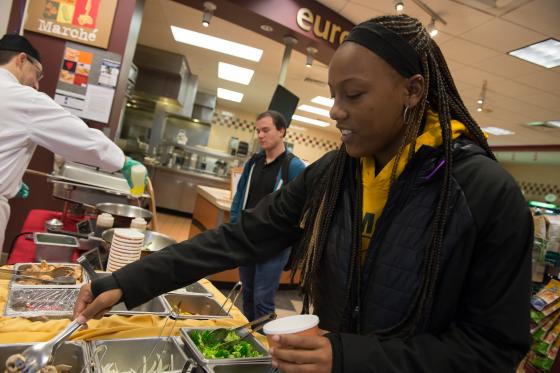Posted June 13, 2016 at 07:08am by Alison Nihart
UVM On Track to Surpass Goal for “Real” Food Purchases

University of Vermont is on track to surpass its current goal of purchasing 20 percent local, sustainable, fair, and humane food. In the 2015-2016 school year, 19 percent of the food purchased by UVM Dining qualified as “real” according to the Real Food Challenge, indicating that the institution is likely to exceed 20 percent Real Food by 2020, the current target date.
The Real Food Challenge is a nonprofit organization that supports a national, student-led movement to shift 20 percent of existing university food budgets (equivalent to approximately $1 billion) from conventional agricultural products to local, ecologically sound, fair and humane products by 2020.
“Growing numbers of students across the country are concerned about how their food is produced -- and how it affects farmers, fishers, and workers -- and the Real Food Challenge is a response to that concern,” says Anim Steel, executive director of the Real Food Challenge. The motivation for the Real Food Campus Commitment is to empower students to hold their universities accountable for responsible purchasing decisions.
UVM responded to student interest and signed the commitment in 2012, pledging to purchase 20 percent Real Food by 2020. UVM was the fifth institution to do so and 32 campuses have signed since. Student interns work with UVM Dining to audit purchases at dining venues across campus and submit the data to the Real Food Calculator, an online tool that calculates a university’s percentage. Those associated with the effort at UVM expressed excitement that the changes made over the past four years have brought UVM so close to the 20 percent target so quickly.
To qualify as real, products must meet specific criteria in the categories of local, ecologically sound, fair or humane. Local products must be sourced from within 250 miles of campus. Popular local products include apples from Champlain Orchards and maple syrup from UVM’s own Proctor Maple Research Center. The ecologically sound category includes organic products and seafood that is sustainably sourced. All of the granola, maple syrup, tofu and most fish on campus qualify as ecologically sound. The fair category includes products with certifications indicating that farm workers involved are paid and treated well. Fair Trade coffee and tea are the standard on campus, and UVM is one of few colleges with a Fair Trade banana program. Lastly, there are many qualifying certifications for humane that ensure animals are well treated. Certified Humane (cage-free) eggs make up the highest portion of UVM’s humane category.
UVM Dining serves about 13,000 meals daily and Melissa Zelazny, resident district manager, understands the opportunity each of those meals presents. “We are proud to be creating dining experiences that are better for the planet, healthier for our students and support our local community.” Zelazny is working with others in the UVM food systems community to build a culture that will help students carry these values with them after graduation.
UVM Dining’s demonstrable progress in increasing Real Food purchasing reflects the passion and values at UVM for holistic food systems education and practice. Although the 20 percent goal is within sight, Gina Clithero, student co-chair of the UVM Real Food Working Group (a multi-stakeholder group of students, faculty, administrators and UVM Dining staff), says the work is far from done. “The working group will continue leveraging UVM’s purchasing power to create a sustainable, ethical food system, beyond 20 percent!”
To learn more, visit uvm.edu/realfood.
